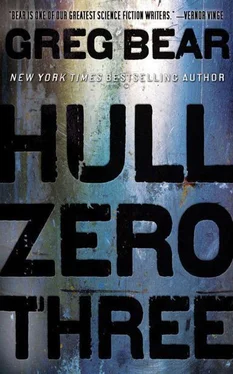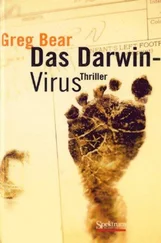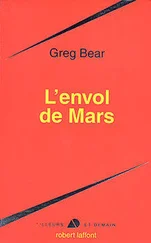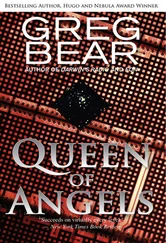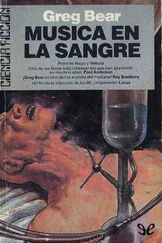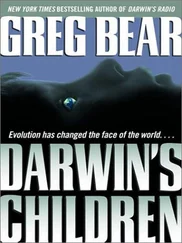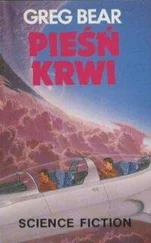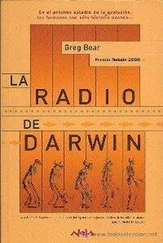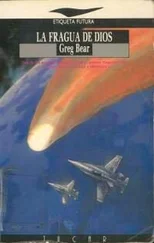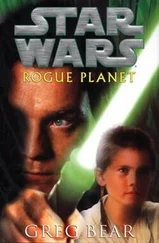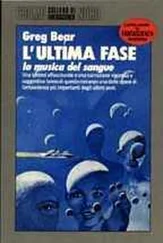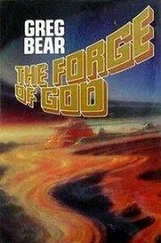“Who’s she talking to?” Tsinoy asks.
“ There you are,” Kim says as a small form seems to materialize from behind him, hanging from a long tail wrapped around a branch. Memory tells me it’s a kind of monkey, but not really. It’s more like a doughnut with five jointed arms and two tails. It does have a general coat of fur, and at the top of the doughnut is a triangular head with eyes arranged in a kind of face, three around a trilateral nose, a fourth on its crown—entirely practical in three-dimensional lodgings.
The voice comes again, in part from the doughnut monkey beside Kim. “Wake them,” it says, speaking without an obvious mouth, through its triangular nose. Now it’s obvious the voice comes from all around. Other doughnut monkeys poke heads, tails, arms through the branches. One settles beside the rime-covered corpses and watches us with bright eyes.
The inhabitants of this leafy tree house number in the dozens—that we can see. Their arms have tiny, agile hands—three fingers and two thumbs. How many more fill the sphere of Destination Guidance? Hundreds? Thousands?
The monkey nearest the corpses reaches up as if to caress a thawing face. It gives a low howl, then shrinks back. “We have died,” the voice says.
“They’re all talking at once,” Nell says. “Just one voice.”
“Are they from the Catalog?” Tsinoy asks me. “Did Ship make them before us?”
Doughnut monkeys do not arouse the same disbelief as the chrome ghost. “Maybe,” I say.
“They aren’t obvious Killers,” Kim says. “No claws, not much in the way of teeth. Big heads, for their body size. They look—”
“Ship requests communication,” the voice says. “Ship requests reconciliation. Wake Destination Guidance and find us a home.”
“I’m confused,” Kim says. “Isn’t Ship dead? Aren’t we inside Destination Guidance?”
“They want us to follow them,” Nell says, watching the way the monkeys are moving, reaching out as if to touch us, pulling arms back at the last minute, then rushing in waves down an opening in the branches. “We can’t all go. Somebody has to stay here with the babies.”
But the monkeys show great concern about the babies. Heads turn. Noses speak.
“Nobody stays behind,” the voice says.
Tsinoy, ever surprising, shows them how she can keep the babies within her bulk, under her armor, in relative warmth and comfort, and Nell finally agrees—they’re better off coming with us.
“Why would they hurt them?” Kim asks. “Didn’t they ask us to find them and bring them here?”
“Use your imagination,” I suggest darkly.
Kim looks mildly aggrieved, then nods.
At least ten of the monkeys—all encouragement, cooperation, and gymnastics—swing out and around us hand to hand. They seem to want us to move away from the corpses, now that there’s no evidence the bodies will ever talk or act again.
The monkeys—the voice—may not be completely stupid. The last of them vanishes into the foliage.
———
THE SPHERE OF Destination Guidance is about five hundred meters in diameter. It seems to be made of concentric layers, floors or inner spheres, most of them plainly deserted and still cooled down. We’re guided by a corridor of warm air as much as anything. Cold keeps us on the right path.
Corridors and conduits push almost straight, or with gentle undulations, through the levels. The design reminds me of the hulls—organic in its seeming disarray, but also organically efficient. As we travel, Nell estimates that the warm air—and the monkeys, occasionally seen up ahead, then moving on—are guiding us on a wide arc toward the foremost point of the sphere.
The journey is interesting because half the foliage along our path is covered with deep frost. Here and there, other monkeys appear who are also still frozen—clinging and thawing to sluggish life.
A few are warm enough to break free and join our entourage.
Kim looks on with wonder. “They were built to freeze down with the sphere,” he says. Tomchin tries to express some idea or another, but we’re too busy to listen, learning our own Tarzan moves in the open spaces between the branches and leaves. (Don’t ask me who Tarzan is. I see ourselves surrounded by monkeys in this elongated forest—even doughnut monkeys—and the name is just there, along with a disturbing image of a muscular human male in a leopard-skin loincloth.)
“Don’t look now, but we’re brachiating ,” I say.
“In public?” Tsinoy asks.
Nell giggles with a hiccup-meowing quality I find entrancing. After all we’ve been through, even as we brachiate , we have to give in to our sense of the absurd.
Tsinoy is the best at putting the word to the deed, moving swiftly, keeping up with the monkeys, but we can’t exactly learn from her, given our natural equipage. As she moves, we hear the infants inside her armor gurgling, cooing, chirping—expressions not precisely happy, but not distressed, either. Is she actually nursing them? Anything is possible. Absurdity is the rule.
I think at this point I feel something like love for our entire weird troupe. It’s the first time I’ve felt such an emotion for real people—though I remember it from the Dreamtime.
People.
My people. Maybe the only family I’ll ever know. And look at them—so many pages from unwritten human history, adapted to so many conditions, but working together, irrationally reaching for a goal, hoping for a purpose. What’s not to love?
The journey is not swift. We’re scratched, sweaty, and irritated in a dozen different ways by the time we reach our destination. It could be a duplicate of the forward control center we left behind us in Hull Zero Three, but it’s overgrown with vines, tendrils, branches, leaves, and even rooted trunks. The monkeys have been here, off and on—warm and cold—for a long time, it seems.
We find two more mummies, completely thawed and not in the least savory. “Who are they?” Nell asks our agile escorts.
“They are us ,” the voice says from all around, and the monkeys settle, some grooming each other, while the majority cling to the branches and watch with so many dark, shining eyes.
“Can we… put them away?” I ask. “They’re dead. They’re not coming back.”
The monkeys think this over. I see a ripple in their odd faces and bodies: muscular twitches, arms and hands shaping subtle gestures. The ripple passes from one side to the other. A monkey wave. They think in serial.
The ripple completes, and together they say, “We are not dead.”
Tsinoy seems to have unique insight into what we’re being told. She’s contemplated form and function and inner being for some time now, and she’s clued in. “They copied themselves… into all of you? Gave you their memories, their jobs, their duties so that you could replace them if they didn’t survive?”
A general light rustling as tails twitch, little hands relax and clutch again. This question is too strange and important for the voice to answer right away.
“Yes,” it says finally. “They are us.”
“Well, that’s fortunate,” Nell says. “Because they need to be disposed of, now that you don’t need them.”
I push toward Nell, and in her ear I whisper, “Who’s in charge, then?” She shakes the question off. It’s way beyond her capacity. Tsinoy hears, however, and makes another creative leap—with another, more important question.
“Why make the babies and bring them here?” she asks.
“They are pure. They will grow to make a choice,” the voice replies.
Tomchin hums to himself, too clearly expressive, and turns away. “Mad Szhib,” he says. We all understand.
Читать дальше
